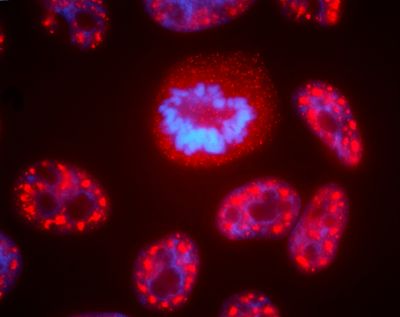Ask Dr. Universe: What are cells made of?

Washington State University
Dr. Universe: What are cells made of? – Lela, 10, Bogart, Georgia
Dear Lela,
You have all kinds of cells in your body that do lots of different things. In fact, there are about 200 types of cells in the human body – from blood cells and skin cells to bone cells. To find out exactly what all those cells are made of, I visited my friend Deirdre Fahy.
Fahy is a scientist at Washington State University who is curious about how and why things work, including our cells. She reminded me the human body is made up of billions of cells. You might think about each cell as if it were a tiny room. But this room, or cell, is so small, you’d likely need a microscope to see it.
Now, picture a kind of barrier around the room that allows different things to move in and out of the cell. That’s the cell membrane. Inside the room, we find a book with a set of instructions. The book is like the part of a cell called the nucleus. It holds all the information, the DNA, that tells the cells how to work.
Each of the cells in your body relies on the same instruction book to do its job. But what makes the cells do different things depends on which section of the instructions they use.
“You could imagine you had this enormous recipe book, but one cell only made breakfasts, and one cell only made snacks, and one cell only made dessert,” Fahy said. “They’re all in the same book, but just some of the recipes are being used by certain cells.”
Of course, the cells aren’t actually cooking you breakfast, snacks or dessert. Instead, they are helping your body do all the things it needs to survive. For instance, some cells use a recipe for building bone material while other cells build muscle tissue. There are cells that carry oxygen around the body, and there are even cells that help you think, feel and move.
Like all things in our universe, the different parts of a cell are made up of atoms. The atoms join to form molecules. One molecule that makes up most of the cell is water. In fact, about 70% of a cell is water. Using its wide range of recipes, the cell can also create other kinds of molecules that help the cell do its job.
You might say each cell has its own recipe for success. In her research, Fahy has used knowledge of how cells work to study everything from the inner workings of plants to why some animals get sick when bitten by ticks that carry a particular bacteria.
When we better understand how cells work, we can learn more about ways to prevent different diseases and improve the health and well-being of all kinds of living things. Who knows, maybe one day you can also use your knowledge of cells – or other parts of science – to help make our world a better place.
Sincerely,
Dr. Universe
Ask Dr. Universe is a project from Washington State University. Submit a question at askdruniverse.wsu.edu.